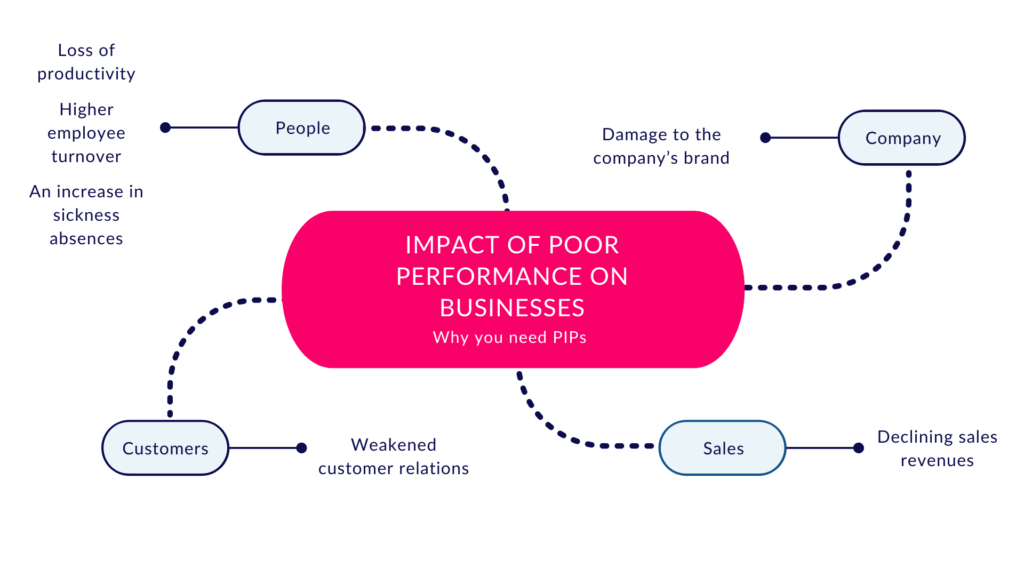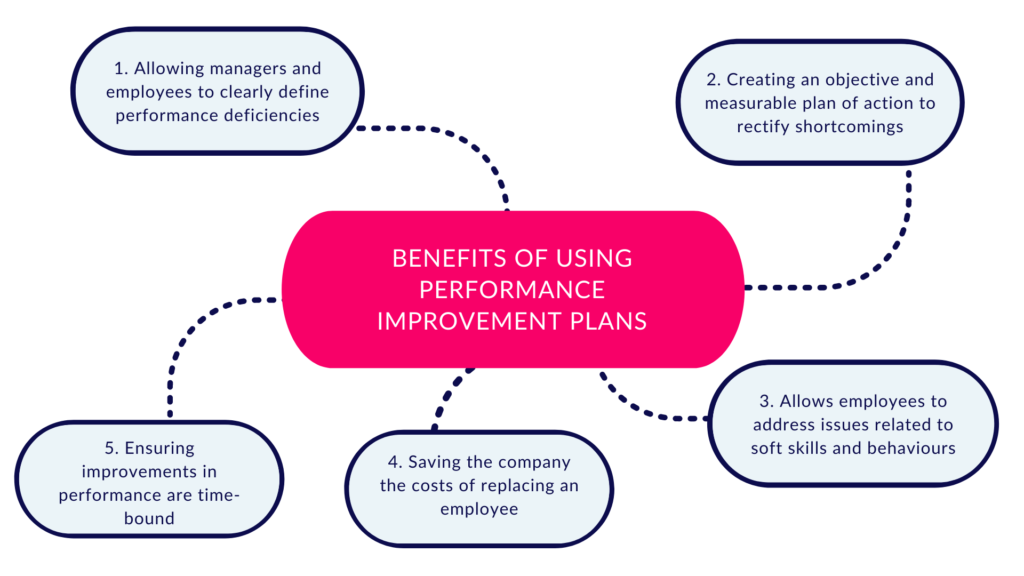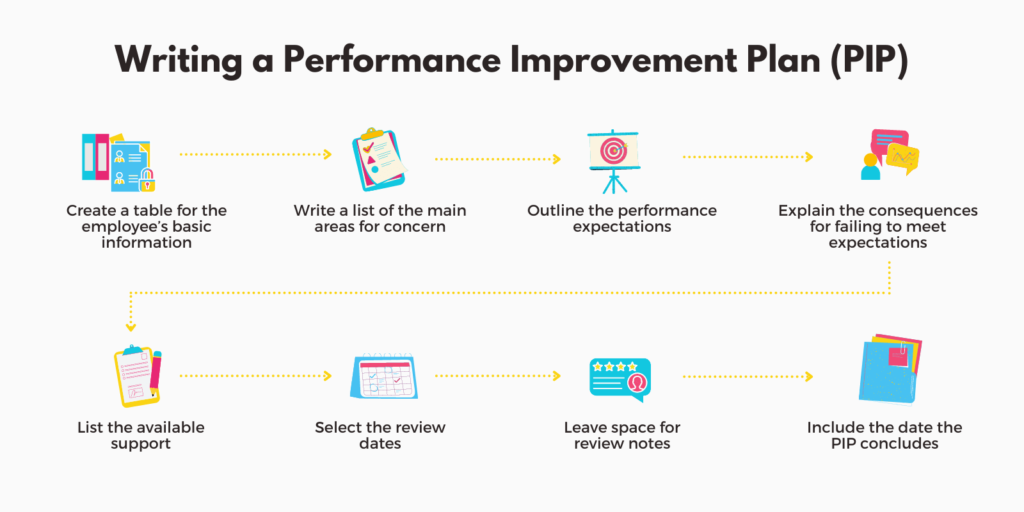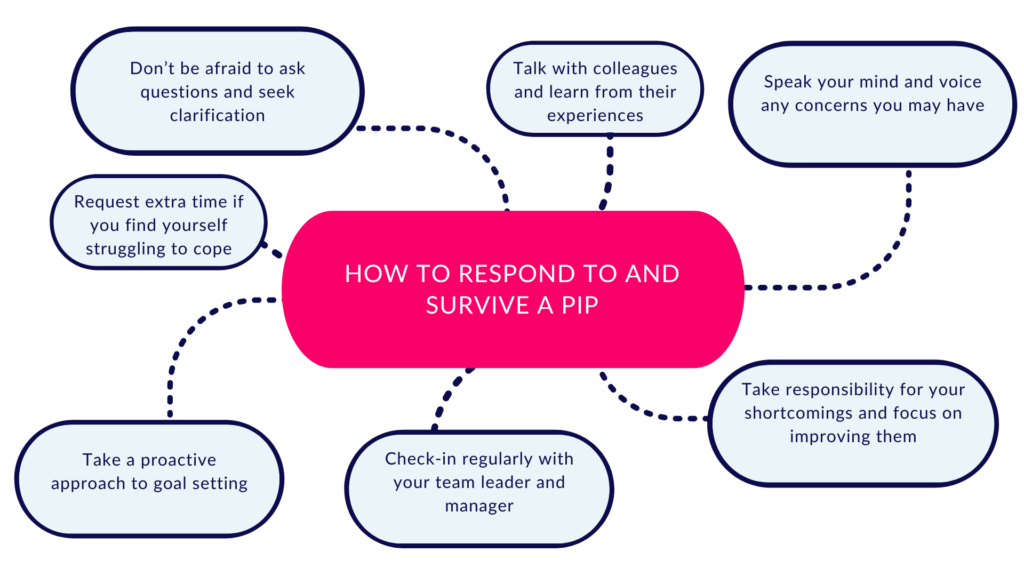What is a Performance Improvement Plan (PIP)?
To define Performance Improvement Plan (PIP), the below are involved:
- its purpose,
- contents, and
- consequences of non-adherence.
- Usually, a PIP document involves the following:
- A detailed report of tasks where the employee is yet to deliver or has failed
- Goal-oriented plan for achieving said targets
- Consequences that the person may face
To create a PIP, it is important to identify the underlying causes, set definite goals, and provide guidance. Using these makes PIP a corrective action as compared to a disciplinary one.
Keep reading to understand the benefits associated with PIP as well as what it entails.
A Performance Improvement Plan (PIP) is a formal document that outlines an employee’s performance issues, along with measurable objectives to address them. Poor performance directly impacts upon a company’s bottom line, making PIPs essential for addressing employee shortcomings and bringing them up to speed.
In this guide, we’ll explore:
- What a performance improvement plan entails
- The benefits of using performance improvement plans
- How to write a performance improvement plan
- How employees can use a performance improvement plan to develop in their role and career
Read on to find out how you can use performance improvement plans to help employees who are struggling the most.
Understanding Performance Improvement Plans
The negative impact of poor performance on businesses comes in many forms. When employees aren’t committed to the company’s success, everyone loses out. A poor performing individual can have a knock-on effect that ripples throughout the company.
This can lead to:
- Loss of productivity
- Overcompensation and resentment from other employees
- An increase in sickness absences
- Declining sales revenues
- Weakened customer relations
- Damage to the company’s brand
- Declining morale
- Higher employee turnover

Performance improvement plans are designed to tackle poor performance at the root of the problem. By taking the underperforming employee and giving them a clear set of goals to improve, performance improvement plans reframe challenges as opportunities for employee success.
A performance improvement plan is typically used following a poor performance review. This plan serves as a final opportunity for the employee to address performance issues to avoid dismissal or demotion. By providing clear objectives, this plan leaves no room for misinterpretation, as well as a clear timeframe to meet these expectations.
Additional Read: Guide to Manage Employee Performance
What Are the Benefits of Using Performance Improvement Plans?
Performance improvement plans offer a range of benefits, both for the individual experiencing poor performance, and the company at large.
These benefits include:
1. Allowing Managers and Employees to Clearly Define Performance Deficiencies
Crafting a personal improvement plan requires managers and employees to collaborate closely together to clearly define the areas for improvement. This process of ongoing conversations also helps to lay the groundwork for the implementation of the plan itself.
Managers and team leaders can marshall the necessary data and resources to make sure the employee fully understands where they’ve been going wrong. At the same time, the employee can bring their own evidence to the table as to why their performance has been lacking.
This process makes sure managers and employees are on the same page about the issues – and potential solutions – surrounding performance. Employees often lack awareness of the details around poor performance, just as managers can be unaware of important context. This collaborative approach to creating performance improvement plans helps to avoid these pitfalls.
2. Creating an Objective and Measurable Plan of Action to Rectify Shortcomings
Clearly defined performance issues allow for the creation of an objective and measurable plan of action. If an employee is failing to secure sales leads, the performance improvement plan can include specific leads to measure improvement.
Tracking and monitoring these goals can be achieved through performance management software. By inputting improvement goals as key performance indicators (KPIs), employees and managers can track them in real-time and jointly address any issues as and when they arise.
3. Allows Employees to Address Issues Related to Soft Skills and Behaviours
Performance improvement plans are not just useful for addressing issues directly relating to the expectations of a given role. They can also be used to help address behavioural concerns and poor soft skills which are affecting an employee’s general performance.
Lack of communication, confusing presentations, and an inability to work harmoniously with colleagues are all issues that can drive poor performance. Some employees are great at meeting their targets but are prone to causing drama and issues in the workplace.
A performance improvement plan can be crafted that specifically seeks to address a lack of people skills which negatively impacts the broader workforce.
4. Saving the Company the Costs of Replacing an Employee
Hiring a new employee to take on the role of an underperformer is an incredibly costly and time-consuming process. Screening CVs, conducting interviews, then onboarding and training the final candidate are all processes managers and HR leaders would prefer to avoid.
By implementing a successful performance improvement plan, business leaders are able to avoid the excessive costs of replacing a member of staff.
5. Ensuring Improvements in Performance Are Time-bound
One of the reasons why underperforming employees have such a negative impact on an organisation is due to the unwillingness of managers to confront the issue. Often, it’s easier to ignore the problem than it is to face up to it, particularly when the conversation may steer towards letting an employee go.
Performance improvement plans offer a mechanism to resolve performance issues by a specific date. When managers are clear as to the consequences of failure – and how this is measured – poor-performing employees are no longer able to coast along. Rather, they have a clear and time-bound understanding of both expectations and consequences.

Why Do Employees Need Performance Improvement Plans?
A performance improvement plan gives underperforming employees an easy-to-follow formal document that outlines the expected standards. The plan’s content clearly details performance issues and the steps needed to address them.
At the same time, the structure of the plan helps the employee increase their levels of engagement, reduces the risk of burnout, and encourages continuous communication.

Increasing Engagement
A lack of engagement is one of the main factors which drives poor performance. Disengaged employees can cost their employers considerable sums of money over time, not to mention dragging down colleagues and reducing morale.
The article from Forbes magazine, How Much Are Your Disengaged Employees Costing You?, outlines the raw numbers in terms of losses for companies that fail to address this issue.
“According to Gallup, disengaged employees have 37% higher absenteeism, 18% lower productivity and 15% lower profitability. When that translates into dollars, you’re looking at the cost of 34% of a disengaged employee’s annual salary, or $3,400 for every $10,000 they make.”
The article continues:
“A single disengaged employee at the average salary level is going to cost you almost $16,000 per year. Raise their salary to $60,000, and they will cost you $20,400 per year. Increase their salary to $80,000, and their disengagement is costing you $27,200 a year.”
By setting up a performance improvement plan, disengaged low performing employees have a structure and routine which demands daily engagement. Frequent milestones, ongoing conversations with managers, and regular reviews all help ensure the employee is consistently engaging.
To further enhance engagement through performance improvement plans, you can tie the goals to the individual’s personal development goals. When work-related goals confer some benefits on the employee that take in the bigger picture of their ambitions, engagement is likely to skyrocket.
Reducing Burnout
A report from Gallup highlighted the toll burnout takes on organisations. They state:
“Organisations are facing an employee burnout crisis. A recent Gallup study of nearly 7,500 full-time employees found that 23% of employees reported feeling burned out at work very often or always, while an additional 44% reported feeling burned out sometimes. That means about two-thirds of full-time workers experience burnout on the job.”
Performance improvement plans can help to directly address burnout issues that are affecting an employee’s performance. By discussing the role in detail, the plan can be configured to help the underperforming employee overcome challenges that lead to fatigue and stress.
When putting together a performance improvement plan, managers should always be mindful of the role mental health and well-being play in underperformance. Asking questions about these issues is a necessary part of the process of addressing poor performance.
Encouraging Continuous Communication
Performance improvement plans can be set up to specifically address poor communication. At the same time, the processes involved in performance improvement plans offer an effective communications strategy to help employees develop this skill.
Diagnosing areas for improvement requires ongoing conversations with managers and team leaders in order to pinpoint where they are going wrong. Regular reviews throughout the process also help employees to develop stronger communication skills.
Additional Read: Engage Your Employees With Performance Management
Understanding Performance Improvement Plan Process
PIP is undertaken as a targeted intervention to help achieve better target delivery by employees by providing them with corrective guidelines and achievable goals.
For an effective performance improvement process, consider having the following:
- Identify the actual problem the employee is facing
- Definite, time-bound, realistic goals
- Have a plan in place to take much needed action
- Using success indicators to track progress
- Resources should be given to serve as a guide
PIP in performance management can be an effective corrective tool to attain goals, track work done, and receive constructive feedback.
How to Write an Employee Performance Improvement Process
A performance improvement plan can be set up for a range of performance issues. Low attendance, inefficient time management, a lack of productivity, and subpar teamwork are all areas that might need improvement.
Whatever the cause of poor performance is, the basic template for a performance improvement plan remains the same.
Once it has been determined that a pip process is the appropriate course of action, follow these steps:

1. Create a Table for the Employee’s Basic Information
Start out by outlining the basic information of the employee who is undertaking the plan. This includes:
- Employee name
- Employee role
- Team/department
- Manager
- The date the performance improvement plan was created
2. Write a List of the Main Areas of Concern
Next, detail the main areas of concern that need to be addressed. List these areas for concern clearly and concisely to avoid ambiguity. As previously mentioned, these could relate to attendance, productivity, output, teamwork, and anything else directly relating to their poor performance.
3. Outline the Performance Expectations
Here, the improvement goals are listed in full. These should be directly related to the listed areas for concern as concrete action plans which can be easily measured. For example, if low attendance is an area for concern, a related goal might be “take no more than X days’ absence in the next six months”.
The performance improvement plan can be broken down into a list of goal-related activities. The employee can then work their way through each of these measurable objectives according to the expected time frame. If necessary, include a note on how to accomplish this activity which the employee can use as a guide.
4. Explain the Consequences for Failing to Meet Expectations
If the employee fails to deliver the expected outcomes of the performance improvement plan, they need to be aware of the consequences. This could mean they face demotion, or in the worst-case scenario failure to deliver on expectations could lead to termination from the company.
5. List the Available Support
Any resources and other areas of support available should be included in this section. This could include online courses or in-person training the employee is expected to attend and complete. It can also include links to digital resources made available by the company, for instance, training videos and resources stored on the company’s internal forums and social intranet.
6. Select the Review Dates
An effective performance improvement plan requires ongoing conversations between the manager and employee. These review dates should be clearly listed in the plan, so the employee understands which milestones they need to reach and when.
To make sure these conversations aren’t overlooked, schedule regular one2one check-ins through performance management software. This will allow the system to send notifications to inform participants of upcoming sessions so they can prepare in advance.
7. Leave Space for Review Notes
Review notes allow managers and employees to take note of any progress made at appropriate intervals. Employees can flag any obstacles which might be hindering their progress, as well as accomplishments that may not be directly covered in the performance improvement plan. These notes can then be fully reviewed at the end of the process.
8. Include the Date the PIP Concludes
Finally, the date on which the performance improvement plan is set to finish should be included. This gives both manager and the employee a clear timeframe within which the stated goals should be accomplished.
How to Respond to and Survive a PIP
Employees who have been tasked with undergoing a performance improvement plan may find the process daunting. There are, however, several ways to approach the process with the correct mindset and turn it into a force for positive change.
When responding to a performance improvement plan:
- Don’t be afraid to ask questions and seek clarification
- Speak your mind and voice any concerns you may have
- Take responsibility for your shortcomings and focus on improving them
- Check-in regularly with your team leader and manager
- Take a proactive approach to goal setting
- Talk with colleagues and learn from their experiences
- Request extra time if you find yourself struggling to cope

Frequently asked questions
Is an Employee Performance Improvement Plan a Step Towards Dismissal?
The goal of a performance improvement plan is to correct performance-related issues which may lead to dismissal. Rather than view it as part of the dismissal process, however, performance improvement plans should be seen as a measure to avoid this outcome.
View it as an opportunity to overcome long-standing challenges and develop new skills. It’s not uncommon for an employee to go through the process and turn things around, and in order to accomplish this, a positive attitude is required.
Is a Performance Improvement Plan a Disciplinary Action?
Performance improvement plans are not considered disciplinary actions. In fact, they are an opportunity to avoid such actions by correcting wayward behaviours. Employees can work closely with managers to address performance issues, developing the necessary skills to become viable team players.
At the same time, employees should be aware of the consequences of failing to live up to the requirements of their performance improvement plan. If this happens, a written warning or more serious measures may be taken by the employer.
What Should a Performance Improvement Plan Include?
A general performance improvement process should include the following:
- Details of the performance or behaviours which need to be improved
- The performance expectations to rectify these shortcomings
- The training and resources to support the accomplishment of these goals
- A timeline for progress, including milestones and reviews
- The final deadline for the conclusion of the performance improvement plan





